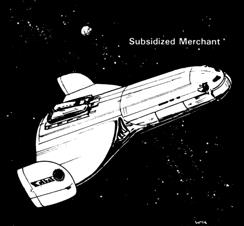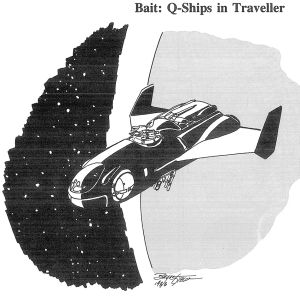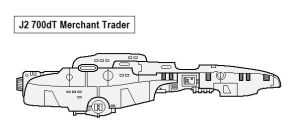Type R class Subsidized Merchant
| Type R class Subsidized Merchant | |
|---|---|
 | |
| Type: RK Subsidized Merchant | |
| Category | ACS |
| Size | 400 Tons |
| Hull Configuration | Airframe Hull |
| Streamlining | Streamlined Hull |
| Tech Level | TL–11 |
| Engineering | |
| Computer | Model/1 |
| Jump | J-1 |
| Maneuver | 1 G |
| Fuel Treatment | scoops, purifiers |
| Armaments | |
| Hardpoints | 2 |
| Accommodations | |
| Staterooms | 13 |
| Low Berths | 9 |
| Personnel | |
| Crew | 5 |
| Pilots | 1 |
| High/Mid Passengers | 8 |
| Low Passengers | 9 |
| Payload | |
| Cargo | 200 Tons |
| Fuel tank | 44 Tons |
| Carried craft | 1 20t Launch |
| Construction | |
| Origin | Third Imperium |
| Year Operational | Unknown |
| End of Service | Still in active service. |
| Price | |
| Cost | MCr91 |
| Statistics | |
| Quick Ship Profile | RK-DA11 |
| Universal Ship Profile | RK-4211111 000000 10001-0 |
| Images | |
| Blueprint | Yes |
| Illustration | Yes |
| Source | |
| Also see | Subsidized Merchant |
| Canon | Published, canon design |
| Designer | Loren Wiseman |
| Design System | Traveller5 |
| Era | 1105 |
| Reference | Starships 36. |
| Starships are designed with the Classic Traveller format, using Traveller 5. | |
Subsidized Merchant (type R). Using a 400-ton hull, the subsidized merchant (commonly called the Fat Trader) is a trading vessel intended to meet the commercial needs of clusters of worlds. [1]. Jump-1. 1-G. 50 tons fuel. Model/1. 13 staterooms. 9 low. 2 hardpoints. Launch. 200 tons cargo. Streamlined. 5 crew. MCr100; 14 months. [2]
Description[edit]
Subsidized Merchant (Type RK): Using a 400-ton airframe hull, the subsidized merchant (often called the fat trader) is a trading vessel intended to meet the trading needs of clusters of worlds, usually under a subsidy. It has class B drives capable of producing jump-1 and 1G acceleration. Fuel tankage supports a 1 parsec jump, at 40t per parsec, and one month of operations. Fuel scoops are integral with the hull, and a fuel purification plant allows use of unrefined fuel. The standard bridge is complemented with a Model/1 computer. The ship has thirteen staterooms (five for the crew; eight for high or middle passengers); there are nine low berths. The ship has two hardpoints; no weapons are mounted. There is one ship's vehicle: a 20-ton launch in a hull niche, for passenger shuttling and minor errands. Cargo capacity is 200 tons. The ship is undertonned, giving it 3G acceleration in atmosphere 2+.
The crew consists of a captain/pilot, astrogator, engineer, medic, and steward. Up to two gunners may be added. The launch is piloted by the astrogator or engineer. The ship can carry eight high or middle passengers and nine low passengers. With the standard discount, the ship costs MCr 91. [3] [4] [5]
Image Repository[edit]

The March Harrier, an Akkigish class Subsidized Merchant
A conversion of a late model Type-R, a Gyro Cadis class Subsidized Merchant, into a Q-Ship.
Palatine class Merchant Trader
Class Naming Practice/s & Peculariarities[edit]
There is no known naming scheme for the Subsidized Merchant. Example ship names include:
- The March Harrier
- The Gyro Cadiz
- The Shaarin Challenger
Variants[edit]
The Type R class Subsidized Merchant is one of the most common starships found within Charted Space. Many variant classes exist of this type.
- The archetypical design is the Akkigish-class Subsidized Merchant. [6]
- Gyro Cadis-class Subsidized Merchant
- Guilder class Subsidized Merchant.
- Palatine class Merchant Trader.
- There are several Sophont variant designs.
The low jump potential of the ship's drives has prompted the production of demountable fuel tanks for this ship. A modular 40-ton fuel tank can be installed in the cargo bay. Installation cuts off the rear doors and makes them unusable. Using these tanks, the ship can make a second one parsec jump with only a twenty hour delay. The delay is required because of standard safety checks required on the ship, and to allow pumping the fuel from the demountable tanks to the wing tanks. Fuel must be in the wing tanks for proper feed to the drives. Cargo capacity of the ship is reduced to 160.0 tons. The demountable tanks cost MCr.5. It is important to remember that these demountable tanks are not collapsible. When removed or not in use, they still take up 40 tons of space, and must be stored or warehoused in some manner. [7]
Class Costs & Revenues[edit]
Costs and Revenues: The monthly payments for a ship of this type amount to Cr416,812. Further expenses for crew, life support, maintenance, and berthing fees amount to Cr82,337 per month, assuming one jump every two weeks. Fuel is free for the skimming at most systems, but would add another Cr5000 per jump if it is required to be purchased. This type of merchant can gross approximately 0546,000 per month, assuming full passenger manifests and a full cargo bay for each jump. A ship owner who depended on full loads for every jump would soon be in trouble. [8]
This ship, however, is a subsidized merchant. The government makes the monthly payments, and also takes 50% of gross receipts. The owner pays all expenses, and thus is responsible for paying the overhead of Cr82,337 per month. The owner also receives half of the gross of up to Cr546,000 per month. In fact, the ship could run at 35% of full load and still make a (small) profit. [8]
The usual text of a subsidy agreement calls for the ship to service an agreed upon route for at least 70% of each year; for the remainder of the year, the ship can undertake charters or service routes to other worlds. In all cases, however, the subsidizing government is entitled to 50% of all receipts, before expenses are paid. In practice, however, the shipowner often resorts to smuggling in order to retain higher profits. Alternatively, the ship owner may sell cargo space to himself and ship speculative goods in that space rather than give up 50% of the profits on such transactions. [8]
Ship Interior Details[edit]
Interior Details: The subsidized merchant is built on a two level plan. The lower deck contains a full access tunnel-type cargo area adapted to containerized cargo. Each cargo module (of 3.85 tons) can be positioned on the deck and removed through bow, rear, or side doors. The cargo-loading templates show the actual configurations which will pass through the various doors. [3]
The lower level also contains the drives and fuel scoops for the ship's tanks. Fuel is contained in the wings and wing-tips. Small crawlways extend into the wings (locations 4 and 5) for access to the landing legs and for exiting beneath the wings. The upper level contains passenger and crew staterooms, the lounges, the bridge, and the galley. The rear portion of the upper level contains the ship's power plant and the low berths. The transverse bulkhead midway through the upper level is a pressure barrier designed to reduce losses in the event of a hull puncture. [8]
The Type R subsidized merchant is streamlined and capable of landing on world surfaces. It generally does so to load and unload cargo. The ship has articulated landing gear, and once positioned for cargo, the ship can kneel, allowing a straight drive on and drive off with cargo. When the landing gear is fully extended, the ship has excellent ground clearance for takeoffs and for underbody maintenance. [8]
Passenger loading is generally performed using the 20-ton ship's launch. The launch calls at the main starport or even at a local hotel's landing pads and picks up passengers booked for the flight. The ship itself is already in orbit, and the launch mates directly with the berth on the ship's dorsal surface. Passengers then board using the launch access hatch. The launch has provision for eight passengers in addition to the pilot. It can carry 9.0 tons of cargo. The launch can also serve as a life boat when necessary. [8]
History & Background (Dossier)[edit]
The Fat Trader is encountered nearly as often as the Free Trader and carries a larger cargo than many smaller ships. It is one of a number of smaller ships that form the backbone of the interstellar economy. Their flexibility can adjust to the rapidly changing variables of interstellar commerce. [9]
The Type R is a venerated design that dates well back to the early Ziru Sirka. As such, it has gone through a tremendous number of cosmetic and physical changes over the more than 1,000 years of its operation. Newer designs and models have made significant advances over the earliest TL–9 variants. The shape and exact form of the fuselage has changed little over this time leaving room for the repair of earlier, lower technology, and thus bulkier ship components. Some current ships have hulls that have been repaired and overhauled dozens upon dozens of time over the centuries with a mix of higher and lower technology components. [10]
Selected Variant Types & Classes[edit]
4 Representative Subsidized Trader (RK) Classes[edit]
References[edit]
| This article has metadata. |

|
This ship was originally designed using one of the Classic Traveller ship design rules:
|

|
This ship was originally designed using Traveller 5th edition ship design rules.
|
- Marc Miller. Starships (Game Designers Workshop, 1977), 19.
- Dave Sering. Starships and Spacecraft (Judges Guild, 1979), TBD.
- Marc Miller. Traders and Gunboats (Game Designers Workshop, 1980), 19-22.
- Marc Miller. Starter Traveller (Game Designers Workshop, 1983), 11.
- Frank Chadwick, John Harshman, J. Andrew Keith, Marc Miller, Loren Wiseman. The Traveller Adventure (Game Designers Workshop, 1983), 129-134.
- Dave Nilsen. The Regency Sourcebook (Game Designers Workshop, 1995), TBD.
- Marc Miller. Aramis (Mongoose Publishing, 2012), TBD.
- Marc Miller. T5 Core Rules (Far Future Enterprises, 2013), TBD.
- Ian Stead, Paul Elliott. Type R Subsidised Merchant Operators Manual (Moon Toad Publishing, 2014), TBD.
- Martin Dougherty. Type-R Subsidised Merchant (Mongoose Publishing, 2015), TBD.
- Ken Pick. Type R2, RL, and RL2 Subsidized Merchants by
- ↑ Marc Miller. Starships (Game Designers Workshop, 1977), 19.
- ↑ Marc Miller. Starter Traveller (Game Designers Workshop, 1983), 11.
- ↑ 3.0 3.1 Marc Miller. Traders and Gunboats (Game Designers Workshop, 1980), 19.
- ↑ Frank Chadwick, John Harshman, J. Andrew Keith, Marc Miller, Loren Wiseman. The Traveller Adventure (Game Designers Workshop, 1983), 129.
- ↑ Marc Miller, Robert Eaglestone, Don McKinney. Starships (Far Future Enterprises, 2019), 36.
- ↑ Loren Wiseman. GURPS Traveller Core Rules (Steve Jackson Games, 1998), 115.
- ↑ Marc Miller. Traders and Gunboats (Game Designers Workshop, 1980), 22-23.
- ↑ 8.0 8.1 8.2 8.3 8.4 8.5 Marc Miller. Traders and Gunboats (Game Designers Workshop, 1980), 22.
- ↑ Information provided to the library by Maksim-Smelchak
- ↑ Information provided to the library by Maksim-Smelchak